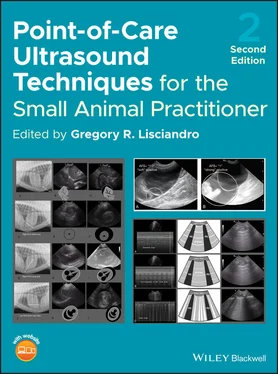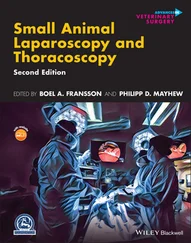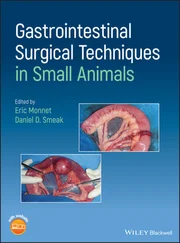The diaphragm is a good landmark and helps locate the liver since the liver abuts the diaphragm.
The liver and right kidney are then fanned through, searching for free fluid and screening for soft tissue lesions.
Typical HR5th Bonus View Positives
Free fluid located around the right kidney and between the right kidney and the liver displacing the right kidney from its renal fossa in dogs. The SR5th bonus view is performed just like the SR view.
The caudal vena cava and other vasculature, aorta and portal vein, run through this region and can be confounders for free fluid (see Chapter 26). Color flow Doppler and holding the probe stationary in B‐mode and watching for pulsation are other options to differentiate free fluid from venous or arterial blood flow. These vessels are generally not problematic at the SR and SR5th bonus views.
Similar to the other AFAST views of missing small volumes, thus always performing at least one more AFAST is recommended as standard of care even in “stable” patients.
Pearl:The HR5th (and SR5th) bonus views are not part of the AFS.
Pearl:Consider the 5th bonus view as exactly that, a “bonus,” not mandated but considered as an add‐on skill once image acquisition is perfected at the first four AFAST views.
The AFAST‐focused spleen should be performed after every AFAST if the spleen is imaged at the HRU (SRU) view ( Figure 6.35). The author has routinely adopted this practice since the recognition of medically treated anaphylaxis‐induced hemoabdomen in dogs (Lisciandro 2016a,b; Caldwell et al. 2018; Hnatusko et al. 2019; Birkbeck et al. 2019). The approach is that a positive AFAST‐focused spleen for a mass is likely highly specific (the mass is real). In contrast, a negative AFAST‐focused spleen doesn't rule a mass out (dependent on the operator). The AFAST‐focused spleen is a screening test . For more detail, see Chapter 9.
The spleen is identified by the finding of a hyperechoic capsule and the blood supply splitting the capsule.
The slide and fan technique is repeated through successive sections while overlapping between sections. A more detailed evaluation may be found in Chapter 9.
Scan cranially and then caudally to each end of the spleen. The author performs this twice and makes sure that the spleen was maximally imaged at the SR view.
A mass that deforms the capsule of the spleen is always considered a serious finding.
Recording AFAST Findings on Goal‐directed Templates
Recording your findings is imperative for a successful ultrasound program. See Chapter 7and the Appendices.
Pearls and Pitfalls, The Final Say
AFAST is a standardized ultrasound examination with exact clarity of its five acoustic windows and how each is performed. AFAST has been shown to be superior to radiography for not only the detection of free intraabdominal fluid but also the volume through its AFAST‐applied fluid scoring system (Lisciandro et al. 2009, 2015, 2019). Moreover, the AFAST DH view is an important source of patient information for free fluid, volume status, pericardial and pleural effusion and lung conditions. Chapter 7covers clinical integration of AFAST‐acquired information.
AFAST has exact clarity to its five acoustic windows.
AFAST and its acoustic windows are exactly the same no matter the patient positioning.
Each view has target organs that are imaged while looking for free fluid (intraabdominal, retroperitoneal, pleural, pericardial) and lung conditions.
AFAST should be part of any POCUS abdominal examination to make sure that effusions or other obvious target organ pathology are not missed.
Serial AFAST and an assigned abdominal fluid score should be repeated, called the serial exam, four hours after the initial AFAST in all stable patients and sooner if the patient is unstable or questionable.
Quick Reference of Normals and Rules of Thumb
Adult dogs and cats should have no free fluid within their peritoneal cavity or retroperitoneal space (or within the pleural cavity or pericardial sac); however, recent research evaluating anesthetized adult dogs and cats, and puppies and kittens has documented small pockets of free intraabdominal fluid in clinically normal canines and felines.
The originally published AFAST‐applied abdominal fluid scoring system was scored according to number for positive AFAST views (range 0–4) excluding the bonus 5th view that is not part of the AFS. However, to better categorize small‐volume bleed/effusion from large‐volume bleed/effusion, AFS at each respective AFAST view now ranges from 0 (negative) to ½ (small pocket <5 mm in cats and <10 mm in dogs) to 1 (>5 mm cats and >10 mm dogs).
Total AFS remains as originally published, with the categorization of small‐volume bleed/effusion defined as AFS <3 (AFS ranges from 0 to 2½, thus including AFS of 1, 1½, 2 and 2½) and large‐volume bleed/effusion defined as AFS ≥3 (AFS ranges from 3 to 4, including AFS of 3, 3½ and 4).
Expect that ~50% of adult dogs will have an AFS of ½ along the diaphragm at the DH view with maximum dimensions of <3 mm that may not be noticeable in unsedated, unanesthetized adults (Lisciandro et al. 2019). Figure 6.35. AFAST‐focused spleen. The spleen represented by the banana is interrogated by the “slide and fan” approach, overlapping each section as scanning cranially until there is no more spleen and then scanning caudally until there is no more spleen. The author repeats the technique twice. Its hyperechoic capsule and the blood vessels splitting the capsule as in (A) identify the spleen. (B–E) A scan in a dog that has a splenic mass. In (B) and (C) the spleen is unremarkable until at (D) and (E) a mass that disrupts the contour of the splenic capsule is noted, a serious finding.Source: Reproduced with permission of Dr Gregory Lisciandro, Hill Country Veterinary Specialists and FASTVet.com, Spicewood, TX.
Expect ~90% of puppies <6 months of age to have an AFS of ½ to 1 along the diaphragm at the DH view and then with fairly equal distribution between the other three AFAST views of ½ to 1 with maximum dimensions of <3 mm (Lisciandro et al. 2019).
Expect that ~70% of adult cats and kittens <6 months of age will have AFS of ½ along the diaphragm at the DH view and then next most commonly positive in both age groups at the most gravity‐dependent umbilical view (SR view in left lateral recumbency) with maximum dimensions at either of these AFAST views of <3 mm that may or may not be noticeable in unsedated, unanesthetized adult cats and kittens (Lisciandro et al. 2015).
The finding of sonographic striation of the canine gallbladder wall should be considered abnormal in the acute setting (acute collapse and weakness) even when the thickness is in the normal range of 1–3 mm; anaphylaxis, “anaphylactic gallbladder,” and right‐sided congestive heart failure, “cardiac gallbladder,” should be ruled out using the Global FAST approach.
Although rare in cats, a “cardiac gallbladder” may occur with feline congestive heart failure.
Characterization of the caudal vena cava may be grouped as a “bounce” and fluid responsive, “FAT” and fluid intolerant, and “flat” and hypovolemic.
Maximum heights at the FAST DH view may be used to additionally characterize the caudal vena cava (see Tables 7.6and 36.3).
1 American College of Emergency Physicians. 2001. ACEP emergency ultrasound guidelines 2001. Ann Emerg Med 38:470–481.
Читать дальше












